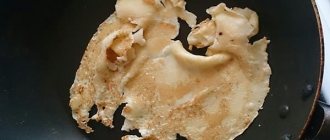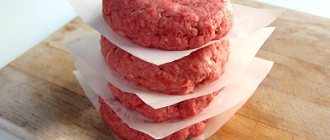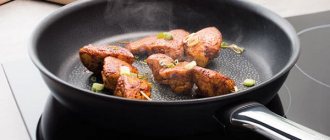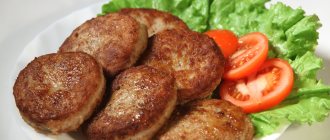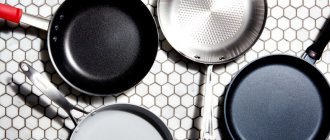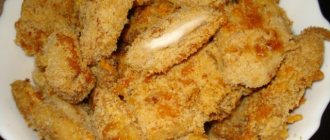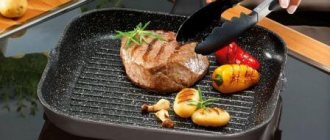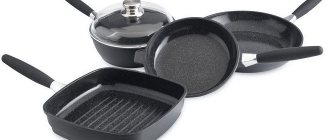This point is familiar to everyone who has at least once tried to fry cutlets, pancakes, fish, chops or anything else in a frying pan without a non-stick coating. At first everything goes according to plan - you heat the pan, add oil, then start frying, and at the moment when it is time to turn the food over to the other side, you realize that it is stuck tightly. At best, you still manage to turn over your chicken breast, cutlet, or whatever you fried, significantly spoiling its presentation; at worst, you fall into panic while your failed dinner, stuck to the frying pan, quickly turns into coals...
[/td]
| Would you like a GIFT from me personally? Enter your email and I will send you a collection of “7 Quick Dinner Menus” - instantly and for free! |
Yes, as always, I exaggerated things a little, but anyone who has encountered such a situation knows that this is not funny at all. Well, in this case, you should be encouraged by the thought that there is a completely rational explanation for what happened, which means that next time it can be avoided. In this article, we will look at why food may stick to the pan, and what to do if this happens to you. So,
Verb: onion
The raw onion that you add to the minced meat should be well chopped: finely chopped with a knife, turned through a meat grinder or grated (the latter method is an excellent prevention of colds: while you grind, you will come out with cleansing tears). In this case, yellow or white onions are usually used. If, like me, you don’t like the onion smell in cutlets “on the exhale” after lunch, fry the chopped onion in a small amount of the fat that you use for the cutlets for literally 3-4 minutes, and then put it in the minced meat. And if you have someone who doesn’t like the pieces of onion that come across in cutlets, beat the fried onion in a blender into a puree - then it will give the meat juiciness and a pleasant shade of taste, but will not be visible at all. And in this case, with heat treatment, in addition to white and yellow onions, you can use leeks and shallots.
Popular reasons for cutlets sticking
Why do cutlets stick to the pan when frying:
- Wrong choice of frying pan . They will almost always stick to steel. It is better to give preference to cast iron or a product with a non-stick coating. In this case, the bottom of the frying pan should be thick, because a thin one does not hold the temperature well and cools quickly, and the cutlets stick more readily to an unheated surface.
- Incorrect operation . Cast iron cookware must be well oiled so that all the pores on the surface are filled and smoothed out.
- Damaged coating . The more scratches, chips, bald spots, the higher the likelihood of sticking.
- Refusal of oil . The oil additionally levels the surface and weakens the chemical reaction between the protein product and metal particles.
- Insufficient heating . Any frying pan is well heated with oil before frying.
- No breading and at the same time wet minced meat. Part of the energy will be spent on evaporating excess moisture, the temperature will drop, and the cutlets will stick.
- Laying too tight . Lots of cutlets in the pan can also lower the temperature and cause sticking. It's best to fry in small batches.
- Some additives to minced cutlet can make it more liquid, which will cause sticking.
To temporarily improve and level the surface of a cast-iron frying pan, you can heat it with salt: “fry” 3-4 tablespoons of salt for three minutes over medium heat, allow to cool, pour out the salt, and wipe the surface with a paper towel.
Then add oil and fry in the usual way. This must be done before each fry until new cookware is purchased.
See also: How to cook porridge. Table with the correct proportions of cereals and liquids.
Variety matters
Just five years ago, potatoes were sold on the market in two or three varieties. So there wasn't much choice. But it also had a universal purpose. It could be boiled, stewed, fried, and used for salads.
Today the assortment is amazing. On the one hand, this is very good. After all, for each dish you can choose a special variety. For example, Bellarosa boils very quickly, so it is more suitable for mashed potatoes and stewed potatoes. But for frying, it is better to choose the varieties “Anosta”, “Lady Claire”, “Nadezhda” or “Saturn”. All of them can be found on the Russian market without any problems. But don’t be too lazy to ask the seller for advice. Especially if you buy at the market.
This is interesting! It is believed that white potatoes are more suitable for boiling or stewing, and yellow or pink ones are more suitable for frying.
Oil is your friend and helper
What happens to food - that same cutlet or piece of chicken - after it is added to a frying pan with hot oil? High temperature instantly evaporates moisture from its surface, turning it into steam. But since the piece of chicken is lying in the frying pan, the steam cannot simply escape, and it lifts the product a little - it turns out to be something like an air cushion that forms a layer between the food and the metal, and prevents their interaction. The problem is that both the food itself and this steam are at a much lower temperature than the oil, cooling it, and if there was not enough oil (or you did not let it heat up properly), its temperature will drop below what is necessary for the water to evaporate, coming out of the product - and that’s all, good news.
Thus, the oil must always be heated properly, almost to the smoking point, but still without allowing it to smoke - and the amount of oil must be sufficient to maintain its temperature at the required level.
Worried about using too much oil? You are right to be afraid - but there are tricks here too, knowing which you can reduce the amount of oil.
Should I cover the pan with a lid?
At the very beginning, while the crust on the cutlets has not yet formed - no, do not cover it. Otherwise, the cutlets will immediately release juice, but you won’t get a crust. As for further actions, there is no clear answer. It all depends entirely on your preferences. A closed lid has two purposes: 1) the cutlets are better fried inside; 2) fat from the frying pan stops splashing the stove. Under the lid, the crust on the cutlets becomes steamed and soggy, they look much less presentable. If you like crispy crust and beauty, both problems are easily solved. The first is by roasting in the oven; the second - using a special mesh lid or simply a crumpled piece of foil that can be thrown onto the cutlets.
Interesting additions to meat cutlets
Even a very old, familiar (and, frankly, a little boring) cutlet recipe can be greatly enlivened by adding one or two new bright ingredients to the minced meat.
TOP 5 tricks to avoid sticking
What to do to prevent the cutlets from sticking to the pan:
- Use high-quality dishes with a thick bottom and an undamaged surface.
- Prepare minced meat of a dense consistency, non-liquid, holding its shape after modeling.
- Use breading (wheat or corn flour, ground crackers, ground walnuts).
- The frying pan with oil needs to be well heated.
- There is no need to take up the entire area of the frying pan with cutlets.
If you don’t have good cookware, but want to fry cutlets, there is a way out. It is necessary to cut a circle of parchment along the diameter of the frying pan, line the bottom with it, pour oil and continue frying as usual.
Which pan does food stick to less?
Of course, the safest option for beginners in the culinary business is a non-stick frying pan. Just don’t think that you need to fry on it without any oil, because that’s not true. It is necessary to add oil, only in the case of a non-stick frying pan you can literally use a drop and not be too careful about the temperature to which it has heated up.
A cast iron frying pan must be heated and lubricated with oil. Yes, yes, precisely lubricate. The oil should penetrate into all pores and cracks, forming an absolutely smooth surface to which food will no longer stick. But the most difficult thing is to fry in a steel frying pan. It heats up quickly but not always evenly, and even if done correctly, food can still stick. To cook in a steel pan, you will need more oil and it is especially important to heat it thoroughly.
What if everything is fine?
If all the risks listed above are excluded, and the cutlets still stick to the bottom of the pan, the following inexpensive and simple life hacks will help you:
- Before frying, cover the bottom of the pan with a circle of parchment paper, which can be easily purchased at any hardware store. It also prevents sticking of other meat and fish dishes.
- “fry” the frying pan thoroughly with salt (3-4 tablespoons per frying pan of standard depth and diameter is enough).
- Dry the cutlets or meatballs before frying by “blotting” them with a clean paper towel or napkin.
Now your cutlets will turn out great! Enjoy them, treat your family and friends as much as your heart desires!
Source
How to fry potatoes without sticking to the pan.
We can easily prepare fried potatoes in the same way. First, wash the tubers, peel and cut into strips. Then place the prepared sheet of parchment on the bottom of the frying pan and pour in vegetable oil. And put the potato slices into the heated oil.
Fry until golden brown.
In principle, we prepare everything as usual, only with a parchment paper lining.
This way the potatoes fry evenly without burning or sticking to the bottom of the pan.
You can cook any product in this simple way on any frying pan, even on an old, scratched and completely damaged one. On gas or electric stove it doesn't matter. Your pan will be clean, and food cooked this way will be evenly and well-cooked without any sticking or burning. All of the above has been tested in practice more than once and will definitely give you the opportunity to save food (oil), time and nerves.
Source
What to do if food is stuck to the pan
Even if you did everything according to the instructions, food may stick. But don't panic. If at first a piece of meat or chicken breast sticks, then there is a high probability that as soon as these products brown a little, they will come off on their own. You can also rock the pan a little to speed up the process, or move the pieces around while frying with tongs.
Vegetables start to stick much faster than other foods, so the best way to save the situation is to stir them regularly at the very beginning of cooking and use more oil. But in the case of cutlets, it is better to add not oil, but a little water. You won’t get that same treasured crust, but the appearance won’t suffer.
If you often cook omelettes, but they always stick, then try lifting the edges with a spatula first, and then rocking the pan, as is the case with meat. But when frying pancakes, they haven’t come up with anything better than greasing a hot frying pan with oil. The first pancake is lumpy only because the frying pan is not yet hot enough at this point.
Even professionals face the problem of cutlets sticking to the pan. But knowing the intricacies of cooking will reduce the “sticky” risk to a minimum.
How long does it take to cook cutlets?
The average frying time is 7 minutes on each side. It is not recommended to close the lid of the pan during cooking. To cutlets
turned out juicy, after frying you need to add a little drinking water and simmer for another 5-10 minutes under the lid.
Interesting materials:
Is it possible to make meringue without parchment paper? Can it be made from sour kefir? Is it possible to cook pizza on foil? Is it possible to wear white to a wedding? Is it possible to come to the military registration and enlistment office earlier? Is it possible to glue the Popsocket onto a silicone case? Is it possible to glue the Popsocket a second time? Can I shower with the MI Band? Is it possible to shower with headphones? Is it possible to take glycine every day?
